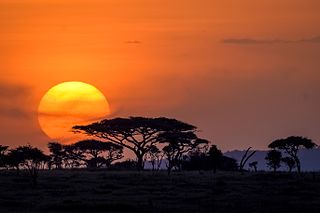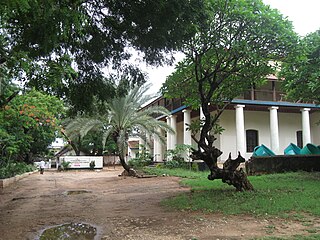
The Kipsigis or Kipsigiis are a Nilotic group contingent of the Kalenjin ethnic group and speak a dialect of the Kalenjin language identified by their community eponym, Kipsigis. It is observed that the Kipsigis and another aboriginal group native to Kenya known as Ogiek have a merged identity. The Kipsigis are the biggest sub tribe within the Kalenjin community. The latest census population in Kenya put the Kipsigis at 1,972,000 speakers, accounting for 45% of all Kalenjin speaking people. They occupy the highlands of Kericho stretching from Timboroa to the Mara River in the south and the Mau Escarpment in the east to Kebeneti. They also occupy parts of Laikipia, Kitale, Nakuru, Narok, the Trans Mara District, Eldoret and the Nandi Hills.

Maasai Mara, also sometimes spelled Masai Mara and locally known simply as The Mara, is a large national game reserve in Narok, Kenya, contiguous with the Serengeti National Park in Tanzania. It is named in honour of the Maasai people, the ancestral inhabitants of the area, who migrated to the area from the Nile Basin. Their description of the area when looked at from afar: "Mara" means "spotted" in the local Maasai language, because of the short bushy trees which dot the landscape.

The Maasai are a Nilotic ethnic group inhabiting northern, central and southern Kenya and northern Tanzania, near the African Great Lakes region. The Maasai speak the Maa language, a member of the Nilotic language family that is related to the Dinka, Kalenjin and Nuer languages. Except for some elders living in rural areas, most Maasai people speak the official languages of Kenya and Tanzania, Swahili and English.

The Serengeti ecosystem is a geographical region in Africa, spanning the Mara and Arusha Regions of Tanzania. The protected area within the region includes approximately 30,000 km2 (12,000 sq mi) of land, including the Serengeti National Park and several game reserves. The Serengeti hosts the world's most massive land animal migration, which helps secure it as one of the Seven Natural Wonders of Africa.

Uasin Gishu County is one of the 47 counties of Kenya located in the former Rift Valley Province. Eldoret has the county's largest population centre as well as its administrative and commercial centre. "It lies between longitudes 34 degrees 50' east and 35 degrees 37' West and latitudes 0 degrees 03' South and 0 degrees 55' North. It is a highland plateau with altitudes falling gently from 2,700 metres (8,900 ft) above sea level to about 1,500 metres (4,900 ft) above sea level. The topography is higher to the east and declines gently towards the western border".

The Mara River is a river that begins in Narok County (Kenya) and ends in Mara Region (Tanzania). It lies across the migration path of ungulates in the Maasai Mara/Serengeti ecosystem.

Maasai or Maa is an Eastern Nilotic language spoken in Southern Kenya and Northern Tanzania by the Maasai people, numbering about 1.5 million. It is closely related to the other Maa varieties: Samburu, the language of the Samburu people of central Kenya, Chamus, spoken south and southeast of Lake Baringo ; and Parakuyu of Tanzania. The Maasai, Samburu, il-Chamus and Parakuyu peoples are historically related and all refer to their language as ɔl Maa. Properly speaking, "Maa" refers to the language and the culture and "Maasai" refers to the people "who speak Maa".
Yaaku is a moribund Afroasiatic language of the Cushitic branch, spoken in Kenya. Speakers are all older adults.

The Ilchamus, are a Maa-speaking people living south and southeast of Lake Baringo, Kenya. They numbered approximately 32,949 people in 2019 and are closely related to the Samburu living more to the north-east in the Rift Valley Province. They are one of the smallest ethnic groups in Kenya.

Narok is a town west of Nairobi that supports Kenya's economy in south-west of the country, along the Great Rift Valley. Narok is the district capital of the Narok County and stands as the major centre of commerce in the district. Narok has a population of around 120,000 people, mostly Maasai. The elevation of Narok is 1827 metres in altitude.

Narok County is a county in southwestern Kenya with an estimated population of 1,157,873 according to 2019 Census. The dominant ethnic group is the Maasai. Its capital and largest town is Narok, with the only other major urban centre being Kilgoris. Narok County Government was formed by the County Governments Act of 2012 as prescribed in the 2010 Constitution of Kenya. Narok County governor is Patrick Ole Ntutu after winning in the 2022 elections and his Deputy is Tamalinye K. Koech.
Kilgoris is a town in Narok County, Kenya. The town has a population of 70,475. Kilgoris is one of two major urban centres in Narok County, the other being Narok Town.

Mara Serena Airport is an airstrip in Maasai Mara, Kenya.

Malindi Museum is a museum located in Malindi, Kenya. It has control over four main heritage sites: The Vasco da Gama Pillar, The Portuguese Chapel, The House of Columns and The Heritage Complex museum.
Narok District was an administrative district in Kenya. The Narok District is located in the Rift Valley Province, and has a population of 365,750. Its capital town is Narok.
Maasai Mara University (MMU),, is a public university in Kenya.
Marley Sianto Sikawa is a Kenyan communications and marketing professional, who served as the tourism marketing coordinator and currently the Assistant Director, Tourism and Wildlife Narok County, one of the 47 administrative Kenyan counties.
Angama Mara Airport is a small airport near Angama Mara in Narok County, Kenya. The airport serves the local areas of the Maasai Mara, national park and nature reserve. The airport was formerly known as Angama Mara Airstrip. In August 2021, the Kenya Airports Authority (KAA) began phased improvements and expansion to convert it to a fully fledged airport.
The Wray Memorial Museum, sometimes called the Sagalla Cultural Museum, is a museum located in Teri, Kenya, and is dedicated to displaying religious artifacts. The museum also exhibits cultural artifacts from the Sagalla community.

The Jaramogi Oginga Odinga Mausoleum is a mausoleum and museum that exhibits artifacts related to Jaramogi Oginga Odinga and other political figures in Kenya's independence process. The museum also displays artifacts related to the Luo culture.












